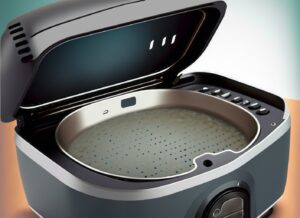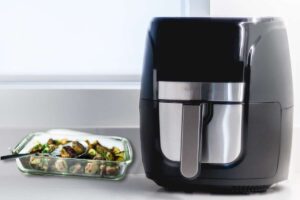Considering an air fryer or convection oven for your kitchen but can’t decide which is right for you? You’re not alone. Both appliances boast the ability to cook food faster and crispier than traditional ovens, but they have distinct characteristics.
Air fryers are essentially mini convection ovens with a focus on rapid air circulation for achieving a deep-fried texture with minimal oil.
If your kitchen counter space is limited, and you crave French fries and crispy chicken wings without the guilt, an air fryer might be ideal. But for those who desire a versatile appliance for baking, roasting, and even dehydrating, a convection oven may be a better choice.
This comprehensive guide will delve into the world of air fryers and convection ovens, exploring their inner workings, key differences, and helping you choose the champion for your culinary needs.
Understanding Air Fryers and Convection Ovens
How Air Fryers Work:
Air fryers are compact countertop appliances that utilize a powerful fan to circulate hot air rapidly around food. This supercharged circulation mimics the convection process in a traditional oven, but at a much faster rate. Most air fryers feature a heating element located on the top, and a perforated basket to hold your food, allowing hot air to bathe it from all directions. The rapid air circulation crisps up the exterior of your food while leaving the interior juicy and tender.
How Convection Ovens Work:
Convection ovens are essentially traditional ovens equipped with a built-in fan. This fan circulates hot air throughout the oven cavity, ensuring more even cooking and faster baking times compared to conventional ovens. Unlike air fryers, convection ovens typically have heating elements on both the top and bottom of the oven cavity. Some convection ovens also offer an “air fry” setting, which essentially uses the fan at its highest speed to mimic the rapid air circulation of a dedicated air fryer.
Unveiling the Key Differences Between Air Fryers and Convection Ovens
While both appliances use hot air circulation for faster cooking, several key differences can influence your buying decision.
Size and Capacity:
Air fryers are generally countertop appliances with a smaller capacity, typically suitable for cooking meals for one to four people. Convection ovens, on the other hand, come in various sizes, from countertop toaster ovens to full-size wall ovens. Their larger capacity allows you to cook bigger batches of food, perfect for feeding a family or crowd.
Heating and Cooking Speed:
Air fryers, with their concentrated heating element and powerful fan positioned directly above the food, tend to cook food faster than convection ovens, especially when it comes to achieving a crispy texture. This is because the hot air blasts the food from above, mimicking the intense heat of a deep fryer.
Fan Placement and Power:
Air fryers typically have a single, large fan located at the top of the appliance. This fan is specifically designed to move air rapidly for achieving a deep-fried-like crispness. Convection ovens, on the other hand, may have a fan positioned in the back, side, or even bottom of the oven cavity. The fan power can also vary, with newer convection oven models boasting stronger fans for their “air fry” settings.
Accessories:
Air fryers often come with a variety of accessories like perforated mesh baskets, trays, racks, and even spits for rotisserie cooking. These accessories help ensure even airflow and promote crispy results. Convection ovens typically don’t come with special accessories, although some manufacturers offer crisper trays designed to mimic air frying.
Cleaning Considerations:
Most air fryer baskets and trays are dishwasher-safe, making cleanup relatively easy. However, their compact size might necessitate more frequent cleaning after every use. Convection ovens, on the other hand, generally require cleaning only of the used accessories, not the entire oven cavity.
Air Fryer vs. Convection Oven: Choosing Your Kitchen Countertop Champion
Now that you understand the key differences between air fryers and convection ovens, it’s time to decide which one best suits your culinary needs. Consider these factors:
- Cooking Frequency: If you plan to use the appliance regularly for small meals or crispy snacks, an air fryer might be sufficient. But for those who bake or roast frequently, a convection oven offers more versatility.
- Desired Food Volume: If you often cook for large families or gatherings, a convection oven’s bigger capacity is ideal. Air fryers are better suited for smaller portions.
- Prioritizing Speed or Versatility: For speed and achieving a crispy texture, air fryers excel. But if you desire an appliance for baking cakes, roasting vegetables, or dehydrating fruits, a convection oven offers superior versatility.
Can You Use a Convection Oven Instead of an Air Fryer?
In some cases, you can leverage your convection oven instead of an air fryer. Convection ovens with an “air fry” setting and a dedicated crisper tray can achieve similar results for smaller batches of food. However, keep in mind that convection ovens may not replicate the rapid air circulation and intense heat of a dedicated air fryer, so you might not achieve the same level of crispiness.
Frequently Asked Questions (FAQs)
1. Is an air fryer healthier than a traditional oven?
Air fryers can be a healthier alternative to deep frying because they use significantly less oil. This translates to fewer calories and less fat consumption. However, air frying isn’t a magic bullet for healthy eating. Just like traditional ovens, air fryers can be used to prepare healthy or unhealthy dishes depending on the ingredients and cooking methods.
2. Can I use a regular oven to air fry?
While you can’t achieve the exact results of an air fryer in a traditional oven, you can get close. Try preheating your oven to the desired cooking temperature for air frying, and place your food on a baking sheet elevated on a wire rack to promote air circulation. This will crisp up the exterior of your food, but it likely won’t be as efficient or fast as a dedicated air fryer.
3. Is a convection oven worth it if I already have a regular oven?
If you find yourself frustrated with uneven cooking or slow baking times in your traditional oven, a convection oven might be a worthwhile upgrade. The even heat distribution and faster cooking times can be a game-changer for baking cookies, roasting vegetables, and achieving perfectly browned meats.
Conclusion
Air fryers and convection ovens are both valuable kitchen tools that can enhance your cooking experience. By understanding their strengths and limitations, you can make an informed decision about which appliance best complements your cooking style and dietary needs. For those seeking speed, countertop convenience, and perfectly crisped foods, an air fryer might be the perfect fit. But if you desire a versatile appliance for baking, roasting, and more, a convection oven offers superior functionality. No matter which appliance you choose, you’re on your way to healthier and more flavorful meals cooked to crispy perfection.





